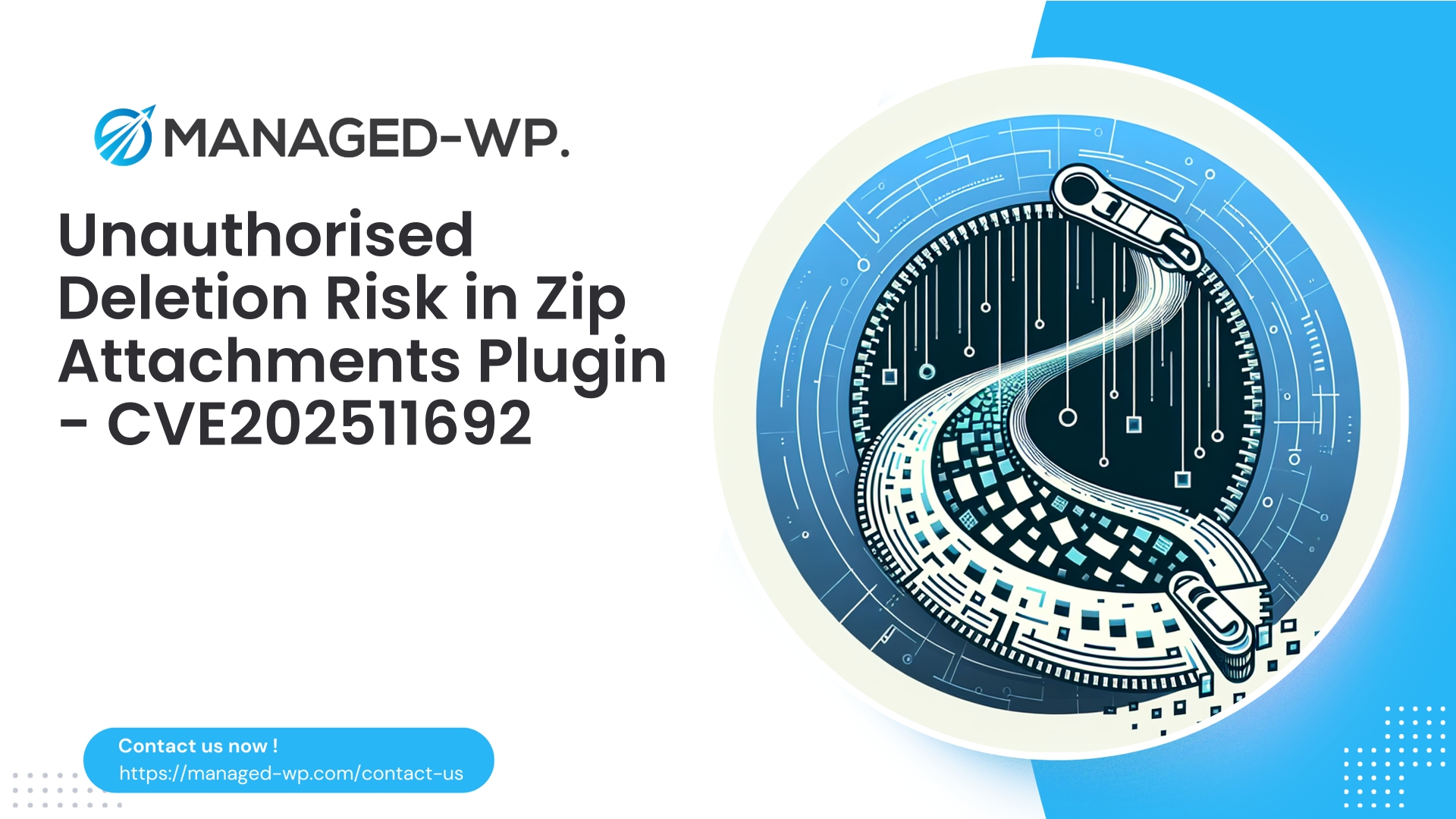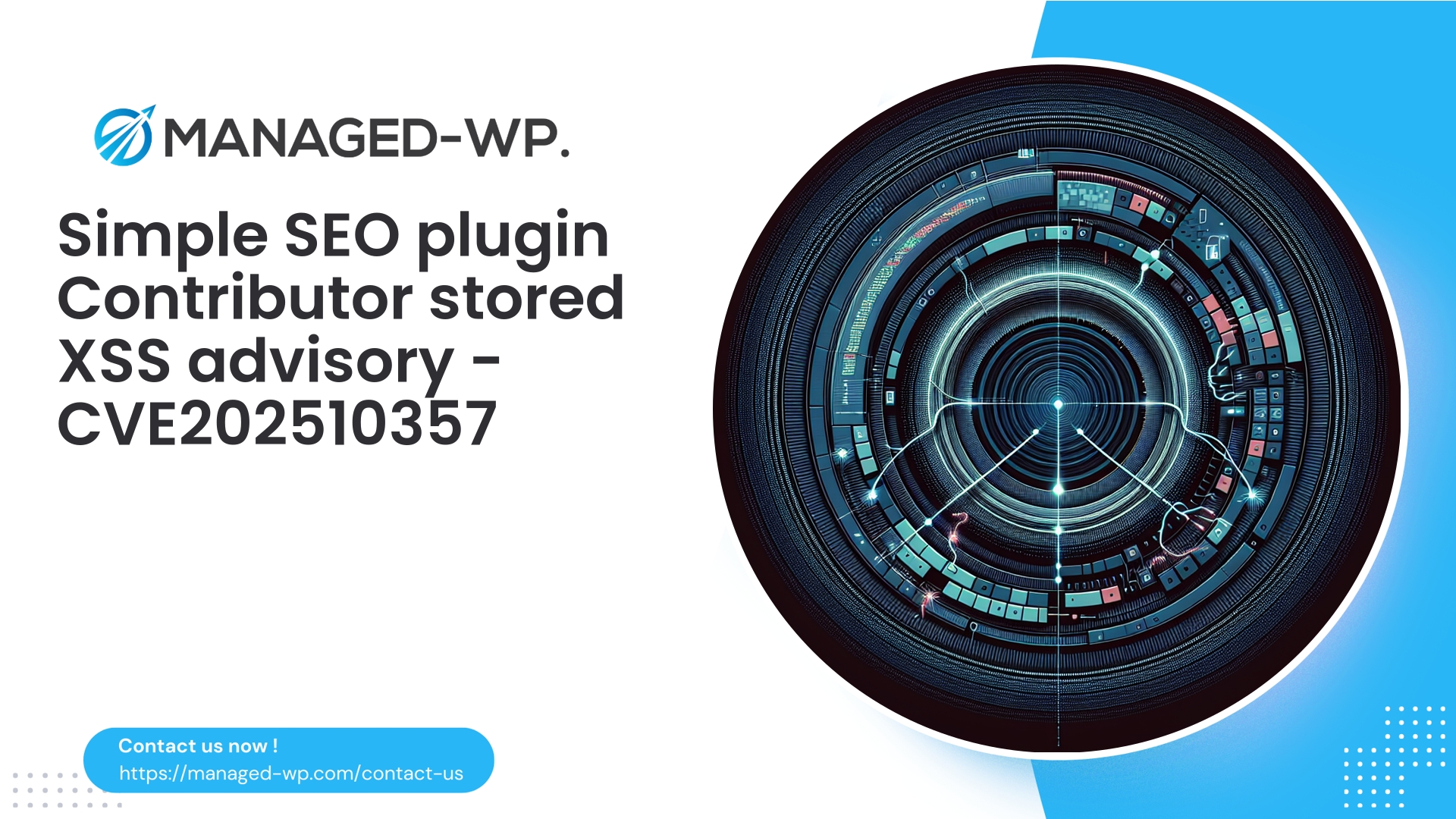| 插件名称 | 拉链附件 |
|---|---|
| 漏洞类型 | 访问控制失效 |
| CVE编号 | CVE-2025-11692 |
| 紧急 | 低的 |
| CVE 发布日期 | 2025-10-15 |
| 源网址 | CVE-2025-11692 |
Zip 附件 <= 1.6 — 缺少有限文件删除的授权 (CVE-2025-11692)
2025年10月15日发布的最新披露的安全漏洞会影响WordPress插件 拉链附件 (版本≤1.6)。该漏洞编号为CVE-2025-11692,属于以下类别: 访问控制失效这是由于对关键文件删除功能的授权检查不足造成的。具体来说,未经身份验证的用户可以构造请求,触发插件管理的某些文件的删除,而无需进行适当的权限验证。
这里 托管WP我们致力于提供切实可行的专家指导,帮助您应对 WordPress 安全威胁。本文将深入剖析此漏洞的技术细节,概述潜在的攻击方法,并详细介绍您可以立即采取的缓解措施——包括如何利用托管式 Web 应用程序防火墙 (WAF) 在供应商发布官方补丁之前提供快速保护。
笔记: 本文重点在于提高安全意识和防御策略,不提供攻击代码或攻击操作指南。
执行摘要
- CVE标识符: CVE-2025-11692
- 受影响的插件: Zip附件(版本≤1.6)
- 漏洞类型: 访问控制失效(缺少授权)
- 所需访问级别: 无(未经认证)
- CVSS评分: 5.3(中低,视具体情况而定)
- 影响: 未经授权删除插件管理的文件(例如,临时 zip 文件和附件),可能会导致某些功能中断、数据丢失或拒绝服务。
- 补丁状态: 截至发稿时,尚无官方修复方案。
- 建议立即采取的行动: 禁用插件,通过 WAF 限制访问,应用虚拟补丁,加强文件系统权限,密切监控站点活动,并在必要时从备份中恢复受影响的文件。
了解漏洞
此漏洞源于插件在未进行适当授权验证的情况下暴露了删除端点——这意味着没有进行 nonce 验证或能力检查(例如, 当前用户可以()这些限制会被强制执行。因此,即使攻击者没有登录 WordPress,也可以发送精心构造的请求,导致插件管理的文件被删除。
主要考虑因素包括:
- 这段存在漏洞的代码旨在删除临时文件或插件特定的 zip 文件(例如归档附件)。
- 未经授权即可在无需登录凭证的情况下删除文件。
- 删除范围仅限于插件控制下的文件,而不是任意文件系统文件,但丢失这些文件仍然可能导致操作问题或数据丢失。
- 潜在的路径验证漏洞可能允许攻击者操纵哪些文件被删除,如果安全措施不足的话。
为什么这个漏洞如此重要
虽然 CVE-2025-11692 并不直接允许远程代码执行,但其影响仍然十分严重:
- 数据丢失: 删除重要的插件生成文件可能会造成永久性丢失,尤其是当这些文件没有在其他地方备份时。
- 服务中断: 依赖插件的 ZIP 生成功能进行内容分发的用户可能会遇到功能失效和工作流程中断的情况。
- 利用连锁风险: 在特定情况下(例如,文件权限松散或其他漏洞),删除操作可能会引发更严重的攻击。
- 自动化适用性: 由于未经身份验证,自动化脚本可以迅速攻击多个网站,从而扩大威胁规模。
- 快速滥用的可能性: 如果漏洞利用脚本或扫描器签名公开可用,漏洞的可用窗口将大大缩短。
与更严重的 WordPress 插件漏洞相比,有限的删除范围降低了其严重性,但运营影响和数据丢失的风险不容低估。
典型攻击向量和端点
这些易受攻击的功能通常通过以下方式运行:
- 请求
admin-ajax.php具有特定动作参数 - 插件创建的 REST API 端点
- 直接访问插件文件(例如,向处理脚本发送 POST 或 GET 请求)
攻击者可能发送的可疑请求示例包括:
/wp-admin/admin-ajax.php?action=zip_attachments_delete&file=/wp-json/zip-attachments/v1/delete?file=- 向
/wp-content/plugins/zip-attachments/handlers.php删除参数
警告: 实际的端点和参数名称应通过查看插件源代码进行验证。
攻击者如何利用这一点
不提供攻击代码,典型的攻击序列包括:
- 通过扫描识别运行存在漏洞插件的 WordPress 网站。
- 通过发送良性请求并分析响应来映射可访问的删除端点。
- 发现触发删除所需的参数(例如,文件名或 ID)。
- 发送未经授权的请求,导致文件被意外删除。
- 通过自动化手段,在多个易受攻击的设施中发起请求,以最大限度地造成破坏。
由于无需身份验证,攻击者可以轻松发起大规模自动化攻击活动。
检测策略
要识别攻击企图或主动攻击,请重点关注以下信号:
- HTTP 访问日志
- 不寻常或频繁的请求
admin-ajax.php具有可疑的“行动”参数。 - 从单个或相关 IP 地址向插件特定端点重复发出 GET/POST 请求。
- 访问与插件命名空间匹配的 REST API 路径。
- 不寻常或频繁的请求
- WordPress 或插件日志
- 没有相应已认证用户活动的删除事件。
- 意外的时间戳或缺失的文件表明存在未经授权的删除行为。
- 文件系统检查
- 插件生成的 zip 文件或临时文件缺失,无法用正常操作解释。
- 重复或批量删除符合插件命名规则的文件。
- 入侵检测/WAF日志
- 阻止了针对删除操作的请求。
- 来自启发式或速率限制规则的警报,重点关注敏感端点。
日志搜索模式可能包括:
admin-ajax.php?action=zip- 缺少引用来源或使用可疑用户代理的请求,并结合删除参数
- 删除端点频繁出现 200 OK 响应,随后出现文件丢失的情况。
立即采取的缓解措施
如果您管理的网站使用了 Zip Attachments 插件,并且无法立即应用补丁(因为目前还没有发布补丁),我们建议采取以下分层缓解措施:
- 停用插件
- 暂时禁用该插件以避免风险。
- 如果对运营至关重要,请考虑访问限制,以便只有授权管理员才能触发其功能。
- 加强文件系统权限
- 严格限制文件删除和写入权限,仅允许对必要的目录执行操作。
- 防止插件或 Web 服务器删除其作用域之外的任意文件。
- 使用 WAF 虚拟补丁
- 创建规则以阻止未经身份验证的删除操作调用。
- 根据会话 cookie 或 IP 信誉限制请求速率和访问。
- 应用Web服务器访问控制
- 通过 Apache/Nginx 规则限制对插件处理脚本的直接访问。
- 尽可能将可信IP地址加入白名单。
- 监控和恢复
- 定期审核上传文件和插件管理的目录。
- 如果检测到文件被删除,请立即从备份中恢复重要文件。
- 参与主机托管和供应商支持
- 如果怀疑存在漏洞利用,请立即通知您的主机提供商进行深入调查。
- 请联系插件作者报告问题并询问补丁可用性。
托管式WP WAF保护:虚拟补丁详解
立即保护网站最有效的方法之一是使用托管式 Web 应用程序防火墙。方法如下。 Managed-WP 的 WAF可以消除此漏洞:
- 自定义规则部署
- 阻止所有未经身份验证且带有可疑的与文件删除相关的“操作”参数的请求。
- 为了
admin-ajax.php调用时,仅当存在有效的已验证会话 cookie 时才允许执行删除操作。
- 随机数和会话验证启发式
- 在删除尝试期间,对缺少有效 WordPress nonce 令牌或管理员会话 cookie 的请求提出质疑或阻止请求。
- 删除 nonce 值格式错误或缺失的请求。
- 速率限制和异常检测
- 限制每个 IP 地址的删除端点请求量。
- 自动检测并屏蔽滥用删除功能的IP地址。
- 虚拟补丁规则示例(概念性)
# 阻止未经身份验证的插件删除操作调用 SecRule REQUEST_URI "@rx /wp-admin/admin-ajax.php" "id:1005001,phase:1,deny,log,msg:'阻止潜在的未经身份验证的 Zip 附件删除操作',chain" SecRule ARGS:action "@rx (?i:zip.*delete|zip_attachments_delete|zip-delete)" "t:none" SecRule &REQUEST_COOKIES:wordpress_logged_in@gt 0 "nolog,skipAfter:END_RULE_1005001" END_RULE_1005001
- 全面日志记录和报告
- 记录所有被阻止的请求及其完整上下文(标头、IP、匹配规则)。
- 提供可视化仪表盘,以跟踪攻击趋势并支持事件响应。
在 Managed-WP,我们的安全团队会不断优化这些保护措施,确保您的网站始终免受不断演变的攻击手段的影响。
开发者最佳实践:正确地修补插件
插件开发者和维护者应遵循以下纵深防御步骤,安全地修补此漏洞:
- 强制执行能力检查
- 在允许删除文件之前,请确认用户拥有适当的权限(例如,
管理选项或者上传文件). - 例子:
if ( ! current_user_can( 'manage_options' ) ) { wp_die( 'Unauthorized', 403 ); }
- 在允许删除文件之前,请确认用户拥有适当的权限(例如,
- 使用 WordPress 随机数进行状态更改操作
- 包含
wp_create_nonce()创建表单或 API 调用时,并使用以下方式进行验证:检查管理员引用者()或者wp_verify_nonce(). - 例子:
check_admin_referer('zip_attachments_delete_action', '_zip_nonce');
- 包含
- 验证并规范文件路径
- 限制删除操作只能在预定义的安全目录中进行(例如,
wp_upload_dir()['basedir'] . '/zip-attachments/'). - 申请
真实路径()对路径进行规范化,并拒绝任何遍历尝试或可疑输入。 - 参数中不允许出现“.”、空字节或绝对路径。
- 限制删除操作只能在预定义的安全目录中进行(例如,
- 限制删除范围
- 通过存储的数据库 ID 而不是任意路径字符串来识别文件。
- 维护允许的文件和目录的白名单验证。
- 实施服务器端速率限制
- 限制破坏性操作以降低滥用风险。
- 综合日志记录
- 记录用户 ID、IP 地址、用户代理、删除目标和时间戳,以便进行审计跟踪。
- 编写单元测试和集成测试。
- 确保只有授权角色才能触发文件删除操作。
- 优雅的故障处理
- 返回信息丰富但内容精简的错误响应,以避免泄露内部细节。
服务器端检查概念示例:
'未授权'), 403); } check_admin_referer('zip_attachments_delete_action', '_zip_nonce'); // 通过 ID 获取文件路径并验证 realpath() 是否在允许的目录中... ?>
事件响应检查表
- 立即停用存在漏洞的 Zip Attachments 插件。
- 检查插件管理的目录,查看是否有文件丢失或删除的迹象。
- 尽可能从备份中恢复已删除的文件。
- 即使攻击不需要身份验证,也应轮换相关的管理员凭据以防万一。
- 检查服务器和 WAF 日志中是否存在可疑的删除请求活动(时间戳、IP 地址、用户代理)。
- 如果怀疑存在更广泛的安全漏洞(未经授权的管理员更改、未知文件、可疑连接),请联系专业的事件响应人员或主机支持人员。
- 一旦补丁可用,就应用永久性修复方案;如果该方案被弃用,则考虑其他插件解决方案。
- 采用虚拟补丁并加强监控,直到官方厂商补丁发布并经过测试为止。
严重程度背景:为何将其归类为低至中等
CVSS评分5.3分反映出中度严重程度,因为:
- 任何没有凭证的人都可以利用该漏洞,这增加了其风险等级。
- 它的影响仅限于删除插件管理的文件,而不是任意文件删除或远程代码执行,从而降低了整体严重性。
- 该漏洞可通过 WAF 规则、监控和配置加固来缓解,与严重的远程代码执行缺陷相比,其紧迫性有所降低。
也就是说,严重依赖插件生成的 ZIP 文件进行关键资产存储的环境可能会遭受重大中断或数据丢失,这凸显了根据自身环境迅速采取行动的必要性。
系统管理员示例检测查询
要主动监控,请在服务器日志上使用以下示例 shell 命令:
- 通过 admin-ajax 检查删除请求:
grep -i "admin-ajax.php" access.log | grep -i "action=zip" | less
- 查找插件 REST API 删除尝试:
grep -i "wp-json/zip-attachments" access.log
- 识别重复请求的 IP 地址:
awk '{print $1}' access.log | sort | uniq -c | sort -n | head - 审核插件目录中最近修改过的文件:
查找 /path/to/wp-content/uploads/zip-attachments -type f -mtime -7 -ls
根据您的设置调整路径和日志。
长期加固建议
- 实施并定期测试可靠的备份和恢复流程。
- 部署主动式WAF来保护管理端点。
- 对插件和上传目录强制执行最小权限原则。
- 保持插件更新并订阅安全公告通知。
- 尽可能隔离第三方插件资源,以减少风险暴露。
立即保护您的网站——从 Managed-WP 的基础免费 WAF 计划开始
无需等待补丁发布——立即使用 Managed-WP 的免费基础套餐保护您的 WordPress 网站。我们的托管式 Web 应用程序防火墙提供强大的防护,可阻止已知和新兴威胁。
基本免费计划包含:
- 托管防火墙可阻止常见攻击模式和新出现的漏洞。
- 无限带宽和全面的WAF规则覆盖。
- 针对 WordPress 攻击载体(包括插件端点)的定向保护。
- 定期进行恶意软件扫描,以检测已知的恶意更改。
- 缓解措施与 OWASP 十大威胁相一致。
立即开始您的免费保障:
https://my.wp-firewall.com/buy/wp-firewall-free-plan/
升级到标准版或专业版,即可获得自动威胁清除和高级控制等附加功能。
常见问题 (FAQ)
问:此漏洞是否允许攻击者删除任何服务器文件?
答:不会。删除操作通常仅限于插件管理的文件,例如临时 ZIP 压缩包。但是,路径验证不当或服务器配置错误可能会增加风险,因此建议采取预防措施。
问:我应该卸载 Zip Attachments 插件吗?
答:如果插件并非关键插件,请停用并卸载。否则,请采取缓解措施,包括启用 Web 应用防火墙 (WAF) 规则和加强权限,直到供应商发布补丁程序。
问:虚拟修补安全吗?
答:是的。Managed-WP 的 WAF 虚拟补丁经过严格测试,可最大限度地减少误报,同时阻止攻击尝试,从而立即降低风险。
问:如果我无法恢复丢失的文件怎么办?
答:优先进行备份以防止数据丢失。如果无法恢复,则评估影响,与相关方沟通,并加强控制以防止进一步损害。可能需要事件响应服务。
Managed-WP 安全团队的最后寄语
访问控制缺陷仍然是 WordPress 插件中最常见的漏洞之一,通常是由于缺少 nonce 验证或对文件删除等状态更改操作的权限检查不当造成的。虽然 CVE-2025-11692 不会直接导致远程代码执行,但它未经授权删除文件的能力会造成破坏性影响。
如果您运营的网站安装了此插件:
- 认真对待这一风险,但要放在正确的背景下看待;其影响有限,但可以采取措施。
- 如果可以,请停用该插件,直到官方发布修复程序为止。
- 使用托管式 WAF 解决方案(例如 Managed-WP 的基本计划)可以快速实施虚拟修补。
- 维护经过测试的备份并持续监控,以确保网站弹性。
Managed-WP 团队密切关注安全漏洞,并迅速采取精准的保护措施,确保客户网站安全。如果您在日志分析、服务器加固或部署虚拟补丁方面需要专家协助,我们随时为您提供帮助。
保持安全并记住:多层防御,结合 WAF 保护、最小权限原则、全面备份和有效监控,可提供抵御 WordPress 安全威胁的最强保障。
参考:
– CVE-2025-11692 官方记录
– 插件作者公告和更新



















